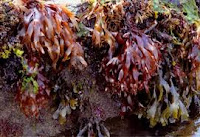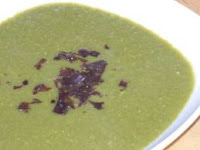DULSE (SEAWEED), PALMARIA PALMATA
Dulse is an edible seaweed as is baldderwrack, laver bread and Irish moss or carrageen, and is a reddish purple colour as is the seaweed from which we get agar-agar. It has been harvested since prehistoric times along the North Atlantic coasts, although was not as popular in North America as it was in Europe. This is changing, however, as people are beginning to understand the health benefits of dulse.
This seaweed is known as creathnach in Irish Gaelic and dilysg in Welsh; it is known as Sheep’s Weed in Scotland and is sometimes also called dilse. This seaweed features in Icelandic sagas, which is not surprising as it grows in abundance around the Icelandic coast, and in one a hero was given dulse and milk to lull him to sleep so that he could be more easily killed. In Welsh legends it features in the Mabinogion of Math, when Math the enchanter builds a boat from dulse.
It has an interesting history in Ireland, particularly in Galway where it was considered a hangover cure. In Threlkeld’s herbal 0f 1726 this is written about dulse:-
“ But in Dublin men chew it like Tobacco when dry, carrying it in their Pockets for that end, which destroys worms and gives a Relish to Beer, as Anchoves or Olives to wine; it is commended against women’s longing.” (?!)
It is still sold in Galway, I’m told, in fishmongers and greengrocers.
 There is a 12th century Irish poem about the duties of monks which mentions dulse, and roughly translated it goes thus:-
There is a 12th century Irish poem about the duties of monks which mentions dulse, and roughly translated it goes thus:- “A while gathering dilisk (dulse) from the rocks,
A while fishing,
A while giving food to the poor
A while in a cell.”
Dulse is found clinging to rocks and is harvested at low tide between the months of June and September, but is unpalatable when fresh as it is tough and leathery. It has to be dried, preferably in the sun, although it can be done in a microwave. You can add it to winter salads of carrots, white cabbage, onions and raisins, or cook with it, putting it in soups or breads and so on.
 In the past it was used to get rid of intestinal worms, to stop constipation as well as to prevent scurvy, as it contains vitamins A and C as well as some of the B-complex vitamins and vitamin E As for minerals it is rich in iodine (as you would expect from a seaweed) along with calcium, potassium, manganese and zinc.
In the past it was used to get rid of intestinal worms, to stop constipation as well as to prevent scurvy, as it contains vitamins A and C as well as some of the B-complex vitamins and vitamin E As for minerals it is rich in iodine (as you would expect from a seaweed) along with calcium, potassium, manganese and zinc. It has been shown t stimulate the thyroid and adrenal glands, thus improving circulation and it can also help lower blood sugar levels and provide a sense of well-being when snacked on. It is high in protein and a good source of dietary fibre, and can now be bought dried in flakes, which can be eaten raw or used in cooking. It is also believed to be good for the proper functioning of the spleen and pancreas.
Dulse is also used commercially as a thickening agent and in cosmetics, as it is nutrient rich and so helps improve the quality of the skin. In fact you can make your own exfoliating scrub with dulse flakes mixed with olive or coconut oil.
You may like to try this recipe for dulse and asparagus soup.
DULSE AND ASPARAGUS SOUP
Ingredients
25 gr. dried dulse (soaked for 10 minutes)
1 bunch green asparagus spears, steamed or boiled
2 medium potatoes, boiled and peeled
1 tsp fresh lemon juice
750 ml. milk
freshly ground black pepper
(Optional spices:; cumin seeds, chilli powder or green Tabasco sauce a little root ginger finely grated)
(Optional spices:; cumin seeds, chilli powder or green Tabasco sauce a little root ginger finely grated)
Method
Cook the dulse in water for 10 minutes. Strain and add lemon juice and black pepper.
Blend the cooked asparagus and potatoes in some of the milk.
Stir the blended mixture into the dulse, in a large pan and heat until boiling. Turn down the heat and simmer for 10 minutes, stirring frequently to prevent a skin forming on the top.
If you are using spices, dry fry the cumin seeds and add them to the blender with the dulse, asparagus and milk along with the chilli and grated ginger.
Serve with fresh crusty bread.
This has Taste and is a Treat.

















